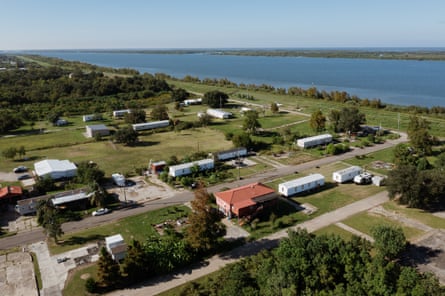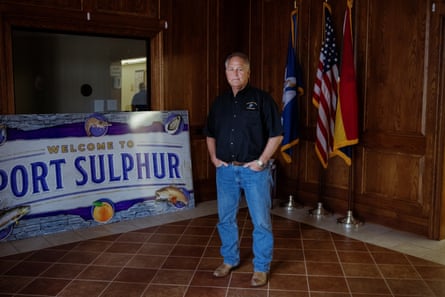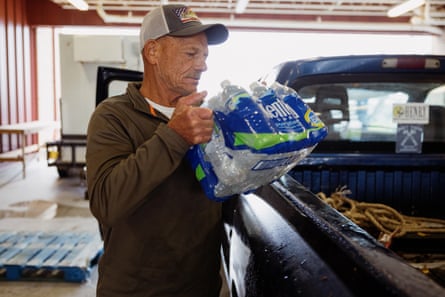The water for a community along Louisiana’s Gulf coast has seen a significant increase in the levels of contaminants known as disinfection byproducts, according to recent state water tests reviewed by the Guardian. According to the Environmental Protection Agency (EPA), long-term exposure to such substances poses an increased risk of cancer.
The findings have emerged as many residents along Louisiana’s southern coast have faced saltwater intrusion from the Gulf of Mexico.
Since early summer, the combination of drought and rising sea levels has helped drag salty water from the ocean up the Mississippi River. The high levels of saltwater have made much of the region’s water undrinkable. But public health experts have also voiced worries that the saltwater intrusion could, over time, corrode the region’s ageing water infrastructure, leach heavy metals into the drinking water and create other knock-on problems.
Recent state testing in the lower Plaquemines parish has shown a spike in two groups of compounds that result from the water disinfection process. The EPA has stated that long-term exposure to these groups of chemicals carries an increased risk of cancer.
Experts who spoke to the Guardian called the jump startling.
“Good Lord,” said Dr Susan Richardson, a chemistry professor at the University of South Carolina who reviewed the findings. “These levels are crazy.”
In most of the country, household tap water has been treated with solutions that kill off bacteria and viruses. This treatment process creates disinfection byproducts, which in small quantities are harmless. However, when seawater enters a water treatment plant, it requires much more disinfecting. And the byproducts formed by disinfecting seawater are especially toxic.
The Port Sulphur water district has had high levels of two groups of disinfection byproducts – trihalomethanes (THMs) and haloacetic acids (HAA5s) – since 2021. Both groups of substances have been linked to cancer by the EPA.
In August, the water district released a public notice acknowledging that total THM levels were above the EPA standard of 80 parts per billion (ppb); testing from earlier this year detected total THM levels at 135ppb and 128ppb, according to the notice.
However, the release states that neither the Louisiana state health department nor the EPA “consider this violation to have any serious adverse health effects on human health as a result of short-term exposure”. “This is not an emergency,” the notice reads. “If it had been, you would have been notified immediately.”

But a test by the state health department on 5 September found that the total THMs within the Port Sulphur water district, which serves 9,000 people, had jumped far more – to 761ppb, or almost 10 times the maximum amount allowed by EPA regulations. Richardson said they were the highest readings she had seen in her career.
That same day, testing at a second sampling site in the Port Sulphur water district detected 676ppb of total THMs. Two weeks later, on 18 September, more testing showed similarly high levels at both sampling sites. In one test, HAA5 levels had climbed to 149ppb.
All tests showed particularly high levels of one toxigenic THM, bromoform, which is created by disinfecting bromide, a compound which naturally occurs in seawater. Richardson said the bromoform levels were more than 100 times what is typical for drinking water, and described this as “super disturbing”. The EPA classifies bromoform as a probable human carcinogen.
In response to a request for comment, Jeff DiMarco, director of public service in Plaquemines parish, said that the parish’s water was safe for drinking and bathing. Asked about elevated levels of THMs, DiMarco said he was not concerned. However, the state department of health confirmed it had initiated increased monitoring of disinfection byproducts.
On 19 October, the parish lifted a drinking water advisory for these lower regions that have gone almost four months without potable water, but within hours was forced to issue a boil water advisory due to a drop in pressure.
In an interview with the Guardian earlier this month over the risks of saltwater intrusion, the Plaquemines parish president, Keith Hinkley, insisted the water was safe to drink.

Experts agreed that the most recent spike in disinfection byproducts was probably triggered by the saltwater intrusion.
“What’s really most likely driving this is the bromide concentration in the seawater,” said Treavor Boyer, a water systems engineer at Arizona State University who has conducted experiments simulating seawater intrusion from the Gulf of Mexico. Bromide levels are low in freshwater, but naturally abundant in both seawater and seaweed.
Richardson, whose research focuses on disinfection byproducts in drinking water, was so taken aback by the test results that she double-checked to ensure the numbers were not missing a decimal place.
Boyer said water test results in Port Sulphur are just what he’d expect from seawater entering a water system. And according to Boyer, the parish’s temporary solution – blending in fresh river water to mix with the seawater – “is creating some very ideal conditions” for increased levels of disinfection byproducts.
‘I would not be drinking that water’
Disinfection byproducts in drinking water are regulated by the EPA to ensure levels stay low. Long-term exposure has been linked to cancer and reproductive effects in lab animals.
after newsletter promotion
THMs as a group “have been most consistently linked to increased risk of bladder cancer”, said Dr Rena Jones of the National Cancer Institute. One study attributed 5% of all bladder cancers in the European Union to THMs. There is also limited evidence to suggest THMs and HAA5s increase risk for colorectal, breast and uterine cancers, said Jones.
There are also some indications that high THM levels can be harmful in the short term. Jones noted that “research studies in laboratory animals have shown some associations between high-level, short-term exposure to some [disinfection byproducts] and damage to the liver, kidneys and nervous system.”
While such research is limited, Richardson said simply: “I would not be drinking that water right now.”
Many residents of the Port Sulphur district have indeed not been drinking the tap water since June due to its saltiness – but THMs are also readily absorbed through skin, and inhaled as steam during warm showers. By some estimates, exposure from just a 10-minute shower is roughly equivalent to drinking 2.5 liters (0.66 gallons) of water.
Erik Olson, an advocate with the Natural Resources Defense Council, called the state test results “very concerning”.
A chemical smell
Disinfection byproducts can be lowered by reducing the amount of organic matter in the water – such as by installing a carbon filter or reverse osmosis machine. The Port Sulphur water treatment plant recently received reverse osmosis and microfiltration machinery. Lab results for the Port Sulphur water cleaned by reverse osmosis are not yet available.
In the meantime, several residents reported a lack of information about the water issues.
“I haven’t ever heard about that,” said resident Katie Mazarac, when asked about the continuously elevated levels of disinfection byproducts.

Residents here have voiced concerns about their water for months. Mazarac has been so concerned about the water since spring that she has conducted at-home water tests and brought her child to a pediatrician to be checked for heavy metals.
All through the summer, residents were alarmed by the water’s condition. “At times, our water would smell like sewage,” said Catherine Vodopija, who was born and raised in lower Plaquemines. “It would bleach our clothes. It would come out foggy and have fumes coming out of the glass … It smelt chemical, like gas and diesel. It was petrifying.”
Public notices of elevated THMs have appeared in Plaquemines’ only local newspaper each quarter, as required by the state. Notices were also mailed to residents’ homes.
But the notice was in English, and lower Plaquemines parish has a large population of Vietnamese immigrants who work on shrimp boats. Sandy Nguyen of Coastal Communities Consulting, which works on language access for coastal fishers, estimates that about 15% of adults in lower Plaquemines do not speak fluent English. Plaquemines is also home to Indigenous members of the United Houma Nation and the Grand Bayou Indian Village.
The region comprises one of the country’s largest seafood ports, and thousands of boats moor here, bringing in shrimp, redfish and oysters.
Long Ly is a Vietnamese immigrant whose English is limited. Since 1997, she has run the shrimp dock on Tiger Pass Road – one of the testing locations where a jump in total THM levels was detected last month.
When asked about her water, Ly said she wasn’t worried. She then swiftly cupped her hands and drank from a tap by the dock’s edge.
“It’s OK,” she said, shaking her hands dry. “A little salt.”
